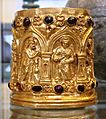Hamsa (bird) facts for kids

The hamsa (Sanskrit: हंस haṃsa or hansa) is an aquatic migratory bird, referred to in ancient Sanskrit texts which various scholars have interpreted as being based on the goose, the swan, or even the flamingo. Its image is used in Indian and Southeast Asian culture as a spiritual symbol and a decorative element. It is also used in a metaphorical sense with the bird attributed with the mythical ability to extract milk from a mixture of milk and water or good from evil. In Hindu iconography, hamsa is the vahana (or vehicle) of Brahma, Gayatri, Saraswati, and Vishvakarma.
Contents
Identification
Asian language professor Monier Williams translates the term from Sanskrit as "a goose, gander, swan, flamingo (or other aquatic bird, considered as a bird of passage [migratory bird] ...)." The word is also used for a mythical or poetical bird with knowledge. In the Rig Veda, it is the bird which is able to separate Soma from water, when mixed; in later Indian literature, the bird separates milk from water when mixed. In Indian philosophical literature, hamsa represents the individual soul or spirit (typified by the pure sunlight-white like color of a goose or swan), or the "Universal Soul or Supreme Spirit".
The word Hamsa is cognate with Latin "(h)anser", Greek "χήν", German "Gans", Dutch "gans", English "goose", Spanish "ganso" and Russian "гусь".
In Hinduism
The hamsa is often identified with the Supreme Spirit, Ultimate Reality or Brahman in Hinduism. The flight of the hamsa symbolizes moksha, the release from the cycle of birth, death, and reincarnation known as samsara.
The hamsa is also the vahana (mount) of Saraswati, the goddess of knowledge and creative arts, Brahma, the god of creation and one of the Trideva (Hindu trinity), and Gayatri, the goddess of vedas.
Paramahamsa
In view of the association of the hamsa with several attributes as indicated above, Hindu rishis (sages) and sadhus (Hindu ascetic or holy person) have been given the title of paramahamsa, that is, the supreme hamsa. It connotes a particular person who has reached a high level of spirituality.
For example, Paramahamsa Upanishad calls that yogi a Paramahamsa who is neither opinionated nor affected by defamation, nor jealous, not a show off, is humble, and is oblivious to all the human frailties. He is immune to the existence of his body, which he treats as a corpse. He is beyond false pretensions and lives realizing the Brahman. In chapter 3, the Paramahamsa Upanishad states that the one who understands the difference between "staff of knowledge" and "staff of wood", is a Paramahamsa.
He does not fear pain, nor longs for pleasure.
He forsakes love. He is not attached to the pleasant, nor to the unpleasant.
He does not hate. He does not rejoice.
Firmly fixed in knowledge, his Self is content, well-established within.
He is called the true Yogin. He is a knower.
His consciousness is permeated with that, the perfect bliss.
That Brahman I am, he knows it. He has that goal achieved.—Paramahamsa Upanishad, Chapter 4 (Abridged)
In Indian text
Hamsa, or hansa, are part of Indian text. Arayanna, or heavenly hamsa (swans), are said to live in Manasasaras in the Himalayas. They are mentioned in the Hindu epic, the Ramayana. Hamsa, the swan, is part of the mythical love story of Nala and Damayanti, where it carries the stories, historical information and messages between the two strangers.
In Indian text, it is said to eat pearls and separate milk from water from a mixture of the two. Charles Lanman states that the references to hamsa being able to separate or discriminate is used primarily in a metaphorical sense in Sanskrit poetry. One possibility is the belief that the milk refers to the sap exuded from the stems of lotuses (kshira). The other, states Lanman, is that "the swan, goose, duck and flamingo have a series of lamellae which serve as a sieve for straining their food from the water that they take in". Thus, it may be referring to the bird's ability to extract the nourishing part from a mixture.
Buddhism
The hamsa was also used extensively in the art of Gandhara, in conjunction with images of the Shakyamuni Buddha. Nanditha Krishna translates this as swan, in the Gandharan context. Martin Lerner and Steven Kossak identify a 2nd-century BCE Gandharan relief now in the collection of the Metropolitan Museum of Art (New York, item 1987.142.212) that shows a swan with a rider.
The hamsa is deemed sacred in the Buddhism, as a symbol of wisdom. Some scholars such as Donald Swearer translate it as swan, others such as Thien Chou as goose. In historic Nepalese art, hamsa are either sketched as a swan or goose-like bird, while in historic Tibetan artwork it appears as goose-like bird likely reflecting the Indian region from where the Tibetan monks borrowed their iconography.
Contemporary usage
The name in other languages in which it is culturally important are Hindi: hans, Kannada: "ಹಂಸ", Telugu: హంస, hamsa Tamil: அன்னப்பறவை Aṉṉappaṟavai; Khmer: ហង្ស, hong; Burmese: ဟင်္သာ, IPA: [hɪ́ɰ̃θà], and commonly spelt hintha or hinthar; Mon: ဟံသာ (ၜိုပ်), IPA: [hɔŋsa] or hongsa; Shan: ႁင်းသႃႇ, IPA: [haŋ˦ sʰaː˨] or hangsa; Thai: hong (หงส์), Thai pronunciation: [hǒŋ]; Malay: angsa (اڠسا). Angsa in Malay language is specifically referred to Anser albifrons.
The hintha (equivalent to hamsa) is widely depicted in Burmese art, considered to be a ruddy shelduck in its culture, and has been adopted as the symbol of the Mon people. In parts of Myanmar, the hintha iconography is more like a hen than a duck, reflecting the local fauna.
Gallery
-
Hamsa talking to Damayanti as depicted by Raja Ravi Varma (19th century)
See also
 In Spanish: Hamsa para niños
In Spanish: Hamsa para niños







